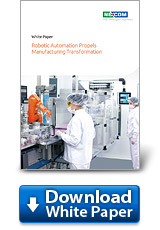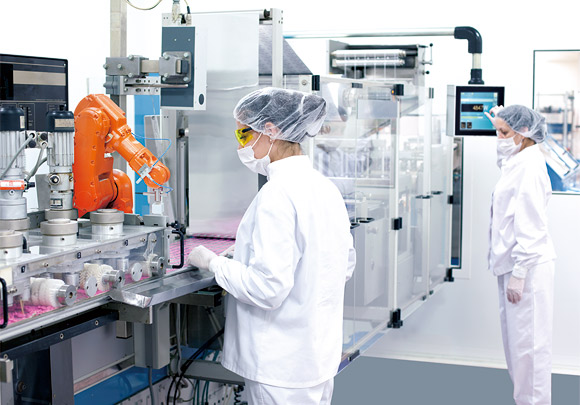Robotic Automation Propels Manufacturing Transformation
 From traditional to electronics manufacturing, many companies are eager to introduce robots to lower labor demand which may drastically shift based on orders. With a production line requiring tens to hundreds of workers for daily operations, manufactures see automated production and man-machine collaboration as ways to secure productivity and to increase production efficiency.
From traditional to electronics manufacturing, many companies are eager to introduce robots to lower labor demand which may drastically shift based on orders. With a production line requiring tens to hundreds of workers for daily operations, manufactures see automated production and man-machine collaboration as ways to secure productivity and to increase production efficiency.
A robotic production line involves aspects more than robots. Issues like system integration, machine-to-machine communication, and information integration must be thoroughly considered to equip a robotic production line with capabilities of actuation controls, sensing, data processing, and operational intelligence as much as smart manufacturing based on IoT, smart robots and cyber-physical systems, and big data technologies.

EtherCAT Helps Implement Robotic Production Lines
"Robotic production lines take meticulous design of robotic movement and distributed control schemes so that all connected equipment and peripheral devices, including robots can be orchestrated to meet manufacturers' high expectations of speedy and precise execution," said Joe Lin, GM of IoT Automation Solutions Business Group, NEXCOM.
A company's packaging lines for wet wipe, for instance, may require 12 to 15 workers each while eight are deployed to perform detail-oriented resealable packing tasks. The company turns to NEXCOM for advice, and NEXCOM has designed an automated system comprising delta robots and EtherCAT master stations to coordinate PLCs, conveyers, sensors, gluing, and labeling equipment all together. The automated system is expected to reduce manpower requirement by about thirty percent and to increase productivity to up to 1.5 packages per second. The company is planning to replicate this model to other assembly lines for different products in order to duplicate the success.
According to Lin, a production line consists of multiple control nodes ranging from robots, machineries, to conveyers. To ensure smooth coordination, EtherCAT master stations amass and fine-tune control variables during operations. With communication jitter measured in microseconds, these nodes can be adjusted instantly while motion cycle is shortened, thus raising overall productivity.
Production Visibility Enhanced with Communication & Information Integration
Automatic production lines are also vital for electronics manufacturers. Different from conventional manufacturers, their automation obstacles are failing data interoperability caused by diverse PLC systems. While making adjustment on single production line is feasible, plant-wide data collection relies on time-consuming, manual transcription.
IoT gateways thus become crucial to automatic production lines as they transcode fieldbus protocols, unifying each system. These gateways break PLCs' protocol barriers so that data can be exchanged. Having process parameters and manufacturing information in hand paves ways for not only on-site and remote monitoring but also big data analysis and decision making.
NEXCOM has developed EtherCAT Master interfaces which are highly interoperable with over sixty PLCs, EtherCAT actuators, I/O and other slave devices from numerous brands. Partnered with local and international firms for integrations with robots, fieldbus communication, control software, and HMI platform, NEXCOM provides last-mile solutions to Industrial IoT. With integration capabilities, NEXCOM has won favors from traditional and electronic contract manufacturers.
To encourage development in robotic applications, NEXCOM recently unveils Robot Package, providing 6-axis robots along with an open control platform. Different from proprietary systems, this platform enables manufacturers to leverage field know-how by writing control algorithms for their own man-machine coordination.
- Related Links:
- NIFE 106: The Little Box That Does Big Things for Industrial Automation!
- Edge Computing and Automation Simplify Path to Green Manufacturing
- Browse Other News:
- NEXCOM’s HPPC Series: High-Brightness Panel PCs Built for Industrial Reliability
- The NDiS B562: Powering Precision in Edge AI and AOI Applications
- All White Papers News
